In late winter, when my skin’s its palest and the sky its grayest, I head southwest to get some sun and some heat. About 2700 degrees worth of heat – the temperature that melts scrap iron down into a molten pool that gets poured into a mold and becomes a sculpture. I’ve made artwork this way for the past eighteen years at an annual cast iron sculpture workshop, called an “iron pour”, at the Mesalands Community College Foundry in Tucumcari, New Mexico.
I always drive there from my home in the Midwest, and at some point meet up with I-44 and then I-40, the highway systems that assimilated the “Mother Road”, Route 66. On either end of the route is Chicago and Los Angeles, but if you’ve ever taken it through the Plains states (Oklahoma and the Texas panhandle) you might not suspect that much is going on besides ranching and collecting wind, as evidenced by all the massive wind farms that have sprung up in the past decade. However, there are several good pit stops for art along the way.
Clarendon, Texas is one such spot, just a left turn off I-40 at highway 70 and a 15-minute drive south. This tiny ranching town is home to John Robert Craft, who lives with his family on Oakes Creek Ranch, the place where he was raised. When he’s not out feeding cows, or baking a loaf of killer sourdough bread, he’s working on making sculpture and prints. Craft is a longtime participant in the Tucumcari iron pour. He makes minimalist sculptures with clean geometric elegance, and prints derived from those sculptures, that he’s exhibited from New York City to Marfa, Texas. I arrived to find him unloading a crate containing a new suite of prints just back from the framer, that included two 10’ long pieces as well as several smaller ones. This body of work is called “Fire Etchings”, published by Flatbed Press in Austin. They’re etched from the “scale”, a crust-like deposit that remains on flat plates of steel set underneath Craft’s iron sculptures when they are put into the annealing oven.



Tucumcari is the next stop. You may have heard of it from the song “Willing” made famous by the band Little Feat (“I’ve been from Tucson to Tucumcari…”), or the scene in the Sergio Leone’s 1965 film “For A Few Dollars More”, where the conductor calls out its name as the approaching railroad stop. It’s only slightly less lonely these days, but during the week of the iron pour, the town grows by about 50 artists who come from all over the US. Since 1997, the foundry at Mesalands Community College has been run by D’Jean Jawrunner, a sculptor raised in Cincinnati who graduated from Miss Doherty’s College Preparatory School (now Seven Hills). Jawrunner’s work is inspired by the flora and fauna of the American Southwest. Her series of cholla towers incorporates patterns she creates from cutting up the woody skeletons of cholla cactus, which she then casts in metals such as aluminum and iron. Her series of jackrabbits are cast in bronze.
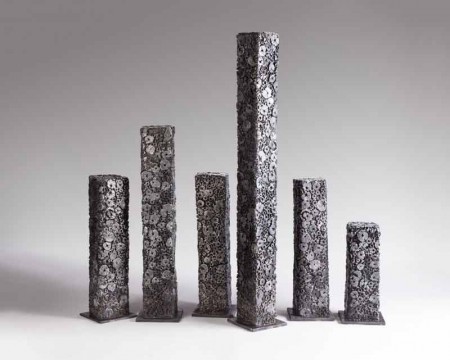


New Mexico native Patrick Garley has attended the iron pour every year since he moved from Tucumcari in the late 1990’s to Palmer, Alaska, where he started his own fine art foundry, Arctic Fires Bronze. In Alaska, where Garley creates large-scale, figurative sculptures for public art commissions, he received the 2016 Governor’s Award for the Arts. This year he was also selected to redesign and cast the trophy for the Iditarod, Alaska’s famed 1000 mile dogsled race, featuring a likeness of the race’s founder, Joe Reddington, Sr. Previously designed and cast out of state, now each year the sculpture will be created locally at his foundry.
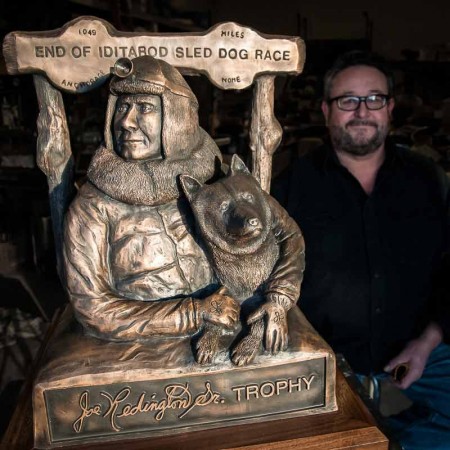
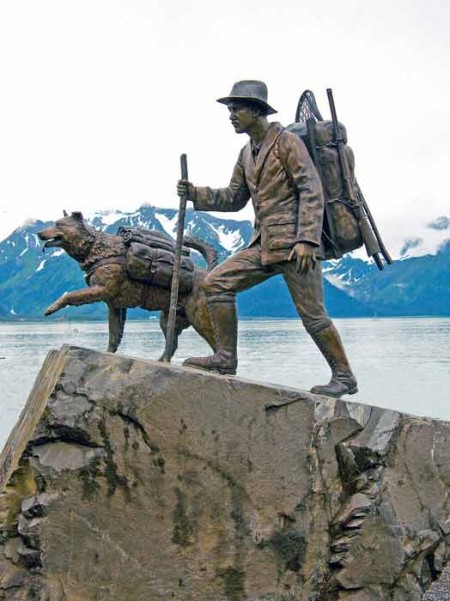
Before leaving New Mexico I traveled further west to Albuquerque, whose lively Central Avenue is the original Rt. 66 as it runs through town. There I met with Basia Irland, an eco-artist known for her intimate, poetic sculptures and installations that incorporate community-based collaborations to address international water issues, water scarcity, and waterborne diseases. Major bodies of her work consist of “ice books”, carved ice tomes with indigenous seeds serving as text, and backpack/repositories created with materials from river sites, designed to carry texts, water, maps, seeds, and other information about specific waterways and regions. She recently returned from Sittard, the Netherlands, where the Museum De Domijnen hosted a retrospective exhibition of her work. Irland visited Ohio in 2012 – 2013 to conduct river projects in Dayton and Yellow Springs, and was featured in the “Ecoventions” exhibition at Cincinnati’s Contemporary Arts Center in 2002. She also has a family connection to Cincinnati – her late husband is the grandson of John Uri Lloyd, one of the three Lloyd brothers who founded the Lloyd Library and Museum.


My return trip included a visit to Tulsa’s Brady Arts District. The neighborhood boasts the historic Cain’s Ballroom, the steel-clad Hardesty Arts Center, built in 2012, and its neighbor 108 Contemporary, as well as a number of other galleries, restaurants, and shops. By the time I arrived, the arts venues were closed, but my curiosity is piqued and I plan on returning next year for a closer look.
The final stop on this trek is well worth the extra hour detour. Just south of I-44 in Missouri is Bentonville, Arkansas, home to the Crystal Bridges Museum of American Art, founded by Walmart heiress Alice Walton and opened in 2011. The museum, designed by Moshe Safdie, is a series of light filled pavillions connected by two bridge structures that span two large ponds. The grounds are lovely, featuring sculptures by Alice Aycock, James Turrell, Roxy Paine, and many more. The museum’s main lobby is accessed by an elevator that descends 3 stories to open on a small courtyard completely occupied by one of Louise Bourgeois’s fabulous spider sculptures.

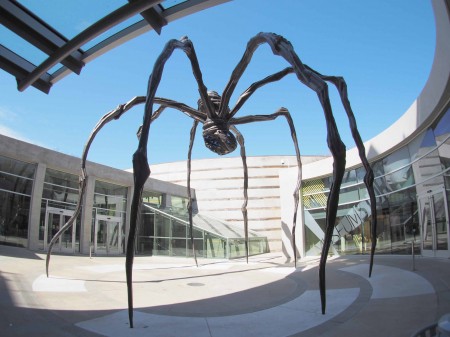
The impressive collection dates as far back as 1675. The 19th century galleries included some exciting discoveries for me, such as Albert Pinkham Ryder’s glowing “Misty Moonlight” from 1885 and Martin Johnson Heade’s incredible irridescent “Gems of Brazil”, a series of 16 paintings of Brazillian hummingbirds and butterflies, from1863-1864. The inclusion of women artists increases significantly as one moves into the 20th century and contemporary collections, with works by artists such as Grace Hartigan, Georgia O’Keefe, Maya Lin, Ursula Von Rydingsvard, and Vija Celmins, as well as lesser known important artists such as Ruth Asawa, a maker of hanging wire sculptures who was interned in an Arkansas prison camp for Japanese-American citizens during WWII and later attended Black Mountain College; Janet Sobel, whose 1940’s drip paintings preceded and possibly influenced Jackson Pollock; and Alma Thomas, a Washington, DC. schoolteacher who later became known for her abstract paintings, and at age 81 became the first African American woman to have a solo exhibition at the Whitney Museum of American Art.
The museum’s new exhibition, “The Open Road: Photography and the American Road Trip”, features images by nineteen American and foreign photographers, presenting an array of cynical, distressing, mundane, and humorous perspectives. Most, though not all, are documentary in nature. The exhibit includes iconic works from Robert Frank, Inge Morath, Lee Friedlander, and Ed Ruscha, as well as contemporary explorations that activate rather than strictly observe environments, by photographers such as Justine Kurland, Ryan McGinley, and Taiyo Onorato and Nico Krebs. The chronologically arranged show begins with a foreboding image for the traveler, Robert Frank’s Car accident—U.S. 66, between Winslow and Flagstaff, Arizona, 1956, depicting spectators assembled around a blanket covered corpse in a barren desert landscape. I was surprised and thrilled to see the work of Jacob Holdt represented here as well. Holdt, a Danish photographer who hitchhiked around the country from 1971-76, often with no money, stayed with whomever offered him shelter and photographed everyone he encountered. By 1976 he had collected 15,000 photographs. His mesmerizing images were presented in this exhibit as he often presented them, as a slideshow, mostly depicting Americans in a corrupt society, facing drug abuse, racism, and poverty. The Open Road runs through May 30.
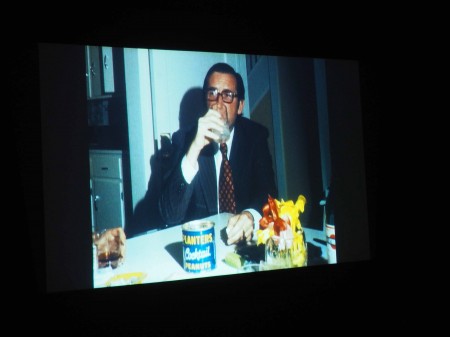
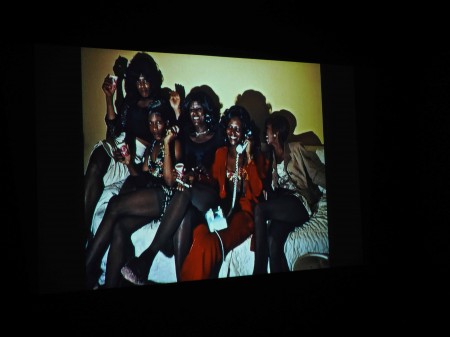
Susan Byrnes is a Cincinnati-based visual artist whose work encompasses traditional and contemporary forms and practices, including sculpture, multimedia installation, radio broadcasts, writing, and curatorial projects.